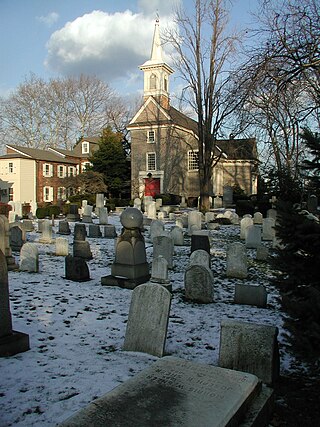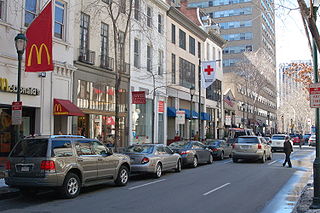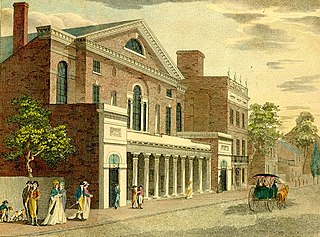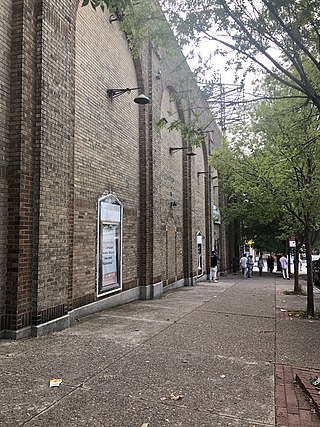
The Philadelphia nativist riots were a series of riots that took place on May 6—8 and July 6—7, 1844, in Philadelphia, Pennsylvania, United States and the adjacent districts of Kensington and Southwark. The riots were a result of rising anti-Catholic sentiment at the growing population of Irish Catholic immigrants. The government brought in over a thousand militia—they confronted the nativist mobs and killed and wounded hundreds.
The Old American Company was an American theatre company. It was the first fully professional theatre company to perform in North America. It also played a vital role in the theatre history of Jamaica. It was founded in 1752 and disbanded in 1805. It was known as the Hallam Company (1752–1758), the American Company (1758–1785) and the Old American Company (1785–1805). With a few temporary exceptions, the Company enjoyed a de facto monopoly of professional theatre in the United States until 1790.

The Theatre of Living Arts is a concert venue located on South Street in Philadelphia, Pennsylvania. The venue, which opened in 1988, dates back to the early 1900s as a nickelodeon. Over the years, the venue has seen many incarnations ranging from concert hall to movie theatre to theatre. Known for its acoustics, it was voted as one of the best concert venues in America by Complex.

Center City includes the central business district and central neighborhoods of Philadelphia. It comprises the area that made up the City of Philadelphia prior to the Act of Consolidation, 1854, which extended the city borders to be coterminous with Philadelphia County.

The Cradle of Liberty Council (#525) is a Boy Scouts of America council created in 1996 with the merger of the former Philadelphia Council and the former Valley Forge Council.

Queen Village is a residential neighborhood of Philadelphia, Pennsylvania that lies along the eastern edge of the city in South Philadelphia. It shares boundaries with Society Hill to the north, Bella Vista to the west and Pennsport to the south. Historically, the area is part of old Southwark, Philadelphia's first suburb, which was incorporated into the city in 1854 and remains the city's oldest residential neighborhood. Street boundaries are the south side of Lombard Street to the north side of Washington Avenue, the Delaware River to 6th Street, encompassing two principal commercial corridors, South Street and Fabric Row on 4th Street.
The Civil War Museum of Philadelphia in Philadelphia, Pennsylvania, claims to be the oldest chartered American Civil War institution in the United States. The museum was founded in 1888 by veteran officers of the Union Army, Navy and Marine Corps.

Walnut Street is located in Center City Philadelphia and extends to the Delaware River waterfront and West Philadelphia. Walnut Street has been characterized as "the city's premier shopping district" by The Philadelphia Inquirer. A portion of the street commonly called Rittenhouse Row was ranked 12th in 2005 by Women's Wear Daily among its list of the most expensive retail streets in North America, with rents of $90 per square foot, and is home to several "upscale dining, retail and cultural" establishments. In 2013, rents rose to an average of $107 a foot, a growth of 34% over 2012 and the largest percentage growth of any retail corridor in the country.

The Wilma Theater is a non-profit theater company located at 265 S. Broad Street at the corner of Spruce Street in the Avenue of the Arts area of Center City, Philadelphia. The company's current 296-seat theater opened in 1996 and was designed by Hugh Hardy.

Thomas Wignell was an English-born actor and theatre manager in the colonial United States.
Leary's Book Store was a landmark in downtown Philadelphia, Pennsylvania, for nearly one hundred years. In 1969, when it closed, it was known as the “oldest book store in the United States.”

The Chestnut Street Theatre in Philadelphia, Pennsylvania was the first theater in the United States built by entrepreneurs solely as a venue for paying audiences.

John Street Theatre, situated at 15–21 John Street, sometimes called "The Birthplace of American Theatre", was the first permanent theatre in the Financial District of Manhattan, New York. It opened on December 7, 1767, and was operated for several decades by the American Company. It closed on January 13, 1798.
The following is a timeline of the history of the city of Philadelphia, Pennsylvania.

John Hodgkinson was a well-known actor in the United States in the late 18th and early 19th century. He was born in England and came to the United States in 1792. William Dunlap and Hodgkinson managed the John Street Theatre together for a few years in the 1790s.

St. Michael's Roman Catholic Church is an active parish of the Roman Catholic Archdiocese of Philadelphia located at Second and Jefferson Streets in Philadelphia, in the West Kensington section of the city.

The Washington Avenue Immigration Station was an immigrant processing facility in Philadelphia, Pennsylvania, United States located at the end of Washington Avenue at Pier 53 on the Delaware River, south of modern-day Penn's Landing waterfront district. The building opened in 1873 and was demolished in 1915.
John Street is a street in Lower Manhattan. It runs north to south through the Financial District. It is one of the oldest streets in the city. Long associated with maritime activity, the street ran along Burling Slip. The slip was filled in around 1840, and the street widened. Besides a wharf, warehouse, and chandlery, the city's first permanent theatre, and the first Methodist congregation in North America were located on John Street. It was also the site of a well-known pre-Revolutionary clash between the Sons of Liberty and British soldiers, pre-dating the Boston Massacre by six weeks.
The Arch Street Theatre in Philadelphia, Pennsylvania, during the 19th century, was one of the three main Philadelphia theaters for plays; the other two were the Walnut Street Theatre and the Chestnut Street Theatre. The Arch Street Theatre opened on 1 October 1828 under the management of William B. Wood. The building's architect was John Haviland.

Masjid Al-Jamia is a Sunni mosque in West Philadelphia. It was founded in 1988 by members of the Muslim Students Association at the University of Pennsylvania . Eight years later, the mosque became independent from the Penn MSA and, around 2009, acquired ownership of the building. Located at 4228 Walnut Street, in a historic building formerly occupied by the Commodore Theatre, the mosque currently serves a large and diverse Muslim population in the neighborhood. The mosque's name itself signals its importance to the community, as the Arabic etymology suggests. In Arabic, Masjid Al-Jamia means “the congregational mosque”, typically where Muslims meet for Friday prayers.













